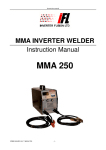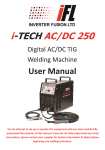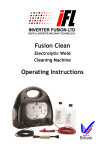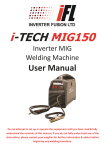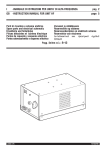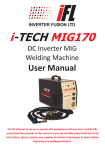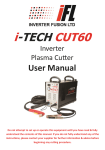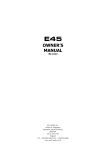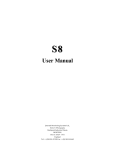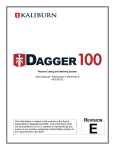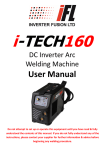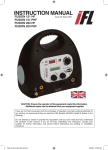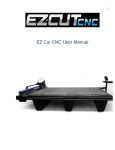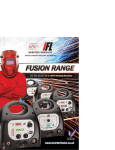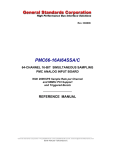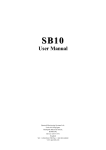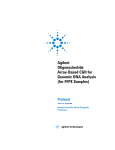Download MIG STAR 315 - Inverter Fusion Ltd
Transcript
Instruction Manual MIGSTAR SERIES Instruction Manual 315A 250A USER MANUAL * MIGSTAR -1- Instruction Manual ________________________________________________________________ CONTENTS GUARANTEE……………………………………………………………………………3 INTRODUCTION………………………………………………………………………..3 Equipment Identification………………………………………………………..3 WARNING……………………………………………………………………………….3 SAFETY REGULATIONS……………………………………………………………...4 HAZARDS……………………………………………………………………………….4 Fire Prevention………………………………………………………………….4 Metal Fume Hazard…………………………………………………………….5 Positioning Power Source……………………………………………………..5 Electromagnetic Field………………………………………………………….6 INSTALLATION…………………………………………………………………………6 User’s Liability and Protection…………………………………………………6 TECHNICAL DATA…………………………………………………………………….7 MODE OF OPERATION……………………………………………………………….8 Shielding Gas Connection………………………………………………..……8 Welding Wire Connection………………………………………………………8 Fitting the Welding Wire………………………………………………………..8 WELDING TECHNIQUE……………………………………………………………….9 Influence of the Welding Position………………………………………….…10 WORKING ENVIRONMENT…………………………………………………………11 MAINTENANCE……………………………………………………………………12-13 TROUBLESHOOTING………………………………………………………………..13 WARRANTY………………………………………………………………………..14-15 USER MANUAL * MIGSTAR -2- Instruction Manual GUARANTEE We give our unreserved guarantee that the Inverter Welding and Cutting Power Source series comply with IEC60974 international safety standard. Maintenance for one year since the date of purchase. INTRODUCTION This manual has been written for professional welders and should be read carefully before using your MIGSTAR welder. The welding machines, type MIG STAR SERIES have been developed for thin plate welding and car body repair. The MIG STAR SERIES are designed to normal single—phase 220-240V 35A or three-phase 380V 20A mains supply. The welding transformer has been dimensioned to obtain optimum welding capacities, and for a working temperature of 150°C. Equipment Identification The unit's identification number (specification or part number), model, and serial number usually appear on a nameplate attached to the control panel. Make a record of these numbers for future reference. WARNING These powerful machines provide exceptional performance for welding of mild steel and stainless steel with high reliability and easy maintenance. Do not attempt to set up, operate or service equipment if not qualified to do so. Contact Inverter Fusion Ltd direct for technical assistance. Welding is a source of radiation, noise, heat and fumes, therefore the protection of the operator and any third persons must be guaranteed with suitable safety precautions. Never approach the arc or hot metal; failure to adhere to these regulations could lead to serious health risks. USER MANUAL * MIGSTAR -3- Instruction Manual SAFETY REGULATIONS 1. Operate the welding power source only on power supply with a reliable well-protected connection point. 2. Use the welder away from flammable material. 3. Use appropriate protective clothing for your hands, eyes and body. 4. Always wear safety glasses with side shield: be aware of others in your work area. 5. Make sure the welding cables and the main power supply are in good condition before carrying out your work. 6. Use the welding power source only in a dry indoor location. If outdoors, use in a place of limited exposure to sunlight and rain. Never use welding equipment near water. Ensure that the surrounding area, including any objects therein and the equipment, is dry 7. Make sure objects do not obstruct the fan cooling system of the welding power source. Always keep the welder well ventilated HAZARDS Fire prevention 1. Keep fire extinguishers, water and sand, within easy reach. 2. Never weld or cut closed containers or pipes. 3. Never weld or cut containers or pipes (even open) containing or which have contained substances that could give rise to explosions, humidity or heat sources. Metal fume hazards Welding fumes and gases may be hazardous if inhaled for long periods of time. 1. Install a natural or forced-air ventilation system in the work area. 2. Use forced-air ventilation system when welding lead, beryllium, cadmium, zinc, zinc-coated or painted materials and wear a protective mask. USER MANUAL * MIGSTAR -4- Instruction Manual 3. Beware of gas leaks. Shield gases such as argon are denser than air, and when used in confined spaces will replace it. 4. Store gas cylinders in a well-ventilated area. 5. Close the main valve when gas cylinder is not in use. 6. Irritation of the eyes, nose and throat are symptoms of inadequate ventilation. Take immediate steps to improve ventilation. Do not continue welding if symptoms persist. Positioning & transporting the power source 1. The operator must have unobstructed access to controls and equipment connections. 2. Do not position equipment in confined, closed spaces. Ventilation of the power sources is extremely important. Avoid dusty or dirty locations, where dust or other debris could be aspirated by the system. 3. Equipment (including connecting leads) must not obstruct corridors or work activities of other personnel. 4. Position the power source securely to avoid falling or overturning 5. Bear in mind the risk of falling of equipment situated in overhead positions. 6. The power source handle or suitable sized nylon webbing may carry the machine. 7. Always disconnect the power source and accessories from main supply before lifting or handling operations. 8. Do not drag, pull or lift equipment by the cable Electromagnetic Field Before installing welding equipment the user should make an assessment of potential electromagnetic problems in the surrounding area. The following shall be taken into account: 1. Other supply cables, control cables, signalling and telephone cables; above, below and adjacent to the welding equipment, radio and television transmitters and receivers, computer and other control equipment. 2. The health of the people around, e.g. the use of pacemakers and hearing aids. USER MANUAL * MIGSTAR -5- Instruction Manual 3. The time of day that welding or other activities are to be carried out. 4. The size of the surrounding area to be considered will depend on the structure of the building. INSTALLATION • Connect the ground lead as near as possible to the operating area. Earth connections to structural parts of the building or to other places distant from the operating area will reduce their effectiveness and increase the danger of electric shock. • Avoid all the direct contact between the skin or wet garments with live metal parts. Check that gloves and protections are dry! • Always wear gloves and rubber soled shoes when working in wet areas or standing on metal surfaces. • Always turn off equipment when not being used or in the event of power failure. Accidental earth discharge may cause overheating and tire hazards. Do not leave the machine unattended when it is turn on. User's Liability and Protection 1. No modifications of the parts of this machine should be carried out. 2. Wear ear protectors; welding operations are often noisy and may disturb other persons in the work area. 3. Position a fire-resistant screen or curtain around the welding area to protect persons in the vicinity from rays, sparks and slag. 4. Compressed gas cylinders are potentially dangerous; consult the supplier for correct handling procedures. Always protect cylinders from direct sunlight flames, sudden temperature changes and low temperatures TECHNICAL DATA USER MANUAL * MIGSTAR -6- Instruction Manual DATA Mains Supply Voltage Maximum Input Current Fuse Cable Cross Section Duty Cycle 20% 30% 60% 100% Voltage Adjustment Open Circuit Voltage Maximum Welding Output Minimum Welding Output Filler Wire Dimensions Wire Feed Speed Timer (Spot or Stitch Welding) Static Characteristics Dimensions (L X W X H) mm Weight Temperature Class Degree Of Protection WELDING MACHINE 250 315 Single Phase 50Hz / 60Hz 3 - Phase 50Hz / 60Hz 230V AC 380V AC 35 Amps 20 Amps 35 Amp (Slow) 25 Amp (Slow) 4 ~ 10mm2 Permissible Loading Loading 250A / 25V -189A / 23.5V -140A / 21V 315A / 29.8V 100A / 19V 244A / 26.2V Output Control 6 Steps 30 Steps 24 ~ 45V DC 18 ~ 38 V DC 250A / 25V 315A / 29.8V 50A / 16.5V 70A / 17.5V 0.6 ~ 1.0 Ø mm 0.8 ~ 1.2 Ø mm 1 ~ 18m / min 0 ~ 5 sec Flat (Constant Voltage) Physical Properties 870 X 310 X 650 950 X 380 X 730 75kg 100kg F 150°C IP21S MODE OF OPERATION USER MANUAL * MIGSTAR -7- Instruction Manual • • • • • • When the trigger at the welding handle is activated, the contactor will couple voltage to the welding transformer, which will give a secondary voltage decided by the position of the voltage switch. In the rectifier this AC voltage transformed into a DC voltage, which is applied between welding, torch and return cable. At the same time the flow of protection gas and the wire feed motor are started. The number of revolutions is decided by the adjustment button. When you lift your finger from the trigger the motor will stop and after a short delay the contactor and the welding current are interrupted. This delay has the effect that the welding wire will burn back a little from the molten pool and thus does not stick to the pool. The electronic control can be set to the functions “continuous”, “spot” and "stitch”. Spot - the welding will stop after a delay that can be set by the button welding time. Using this function you are sure of a uniform stitch welding. Stitch - the wire feed motor will stop with stitch that can be set by the button welding time and pause time. When you put pauses into the welding, the average heat volume added is reduced to prevent a burning through on difficult welding tasks. Shielding Gas Connection The shielding gas bottle is mounted on the machine and the regulator on the bottle. lf the regulator is equipped with a flow meter, the flow rate is adjusted on 515 litres / min. Welding Hose Connection The welding hose is put through the hole in the front plate and into switch on the wire feed console. Keep the inlet nozzle as close to the wire feed roller as possible without letting them touch each other. Fitting the Welding Wire Turn the tension spring aside and tip it up. Check that the wire feed roller, the wire guide liner and the contact tip correspond to the wire diameter; the wire feed roller is designed for one dimension. The following guide shows the recommended wire: WIRE DIAMETER (FE.WIRE) WIRE GUIDE LINER INT. DIAMETER Dia 0.6MM Dia 1.0 –(–1.5)MM Dia 1.0MM WIRE DIAMETER (AL.WIRE) Dia 0.8MM Dia 1.5MM Dia 1.0MM Dia 1.5MM Aluminium Wire When using aluminium wire use a special guide liner where the internal liner goes the way through the inlet nozzle. This prevents the aluminium wire from being USER MANUAL * MIGSTAR -8- Instruction Manual damaged. The reel of wire is put on the hub, and the wire is put through the wire feed unit and some into the hose. As the wire guide liner is prone to burrs at the point of the wire, it is important to straighten out the first 10-15cm. Unscrew contact nozzle. Tip up the level. Set the wire speed at 6, press the start button, the wire runs through the hose. When the wire is through the hose, stop the machine and mount the contact nozzle. The pressure of the lever is adjusted to allow the wire feed roller just to slide on the wire when this is stopped at the contact nozzle. WELDING TECHNIQUE The setting up of a MIGSTAR SERIES welding machine demands some practice from the welder, the machine having two control points that have to meet; the wire feed speed and the welding voltage. The welding current is determined by the wire feed speed, and it should correspond to the work piece. The current will increase by wire speed, resulting in a shorter arc. Less wire speed will reduce the current and lengthen the arc. Increasing the welding voltage hardly alters the current intensity, but lengthens the arc. By decreasing the voltage a shorten arc is obtained with little change in current intensity. When using CO2 as shielding gas, increase the voltage by about 5 volts per 100 Amp. When changing the wire diameters, different control settings are required. A thinner wire needs more speed to acquire the same strength. A satisfactory weld cannot be obtained if extreme values are exceeded. If the feed speed is too high for the welding voltage, blockage will occur in the torch as the wire dips into the molten pool and does not melt. Welding in these conditions normally gives faults due to lack of fusion. If however, the welding voltage is too high, large drops will form on the end of the wire, causing spatter. The correct setting of Voltage and speed can be seen in an even and calm arc. Influence of the welding position The position of the torch and the work piece is important for quality and appearance of the seam. USER MANUAL * MIGSTAR -9- Instruction Manual The diagrams below show some of the many possibilities and indicate schematically the importance of these positions. In practice it is best to use all combinations of welding positions, torch directions and positions of the work piece. Together with the figures, the diagram below may help when an estimation of separate factors for welding quality. The terms drawing weld and thrusting weld mean: Drawing weld: torch sloped in direction of weld. Thrusting weld: torch sloped away from direction of weld. Width of seam Upper bead Penetration Tendency to lack of fusion Thrusting weld Wider Smaller Decrease Greater Push Weld Drawing Weld Narrower Larger Increase Lesser Pulling Weld Push Weld Sloping Downwards Pull Weld Sloping Upwards Pull Weld Sloping Downwards WORKING ENVIRONMENT 1. Shielding Measures should be taken to shield the supply cable of permanently installed welding equipment, in metallic conduct or equivalent. Shielding USER MANUAL * MIGSTAR -10- Instruction Manual should be electrically continuous throughout its length. The shielding should be connected to the welding power source so that good electricalcontact is maintained. 2. Maintenance The welding equipment should be routinely maintained. All access and service doors and covers should be closed and properly fastened when the welding equipment is in operation. In particular, the spark gaps of arc striking and stabilizing devices should be adjusted and maintained. 3. Cables Welding cables should be kept as short as possible and should be positioned close together, running close to the floor level. 4. Earthing Where the work-piece is not bonded to earth for electrical safety, not connected to earth because of its size and position, care should be taken to prevent the earthing of the work piece increasing the risk of injury to users or damage to other electrical equipment. Where necessary, the connection of the work piece to earth should be made by a direct connection to the work. 5. Screening and shielding Selective screening and shielding of other cables and equipment in the surrounding area may alleviate problems of interference. . EQUIPMENT INSTALLATION AND MAINTENANCE MUST BE PERFORMED IN COMPLIANCE WITH LOCAL SAFETY STANDARDS Electric shock could be fatal. Never touch exposed electrical parts. Switch off and disconnect the power source before USER MANUAL * MIGSTAR Use a protective mask with suitable glass filter (at least NRl0) to safeguard eyes. Wear appropriate eye, ear and body protection. -11- Fumes and gases may present a safety hazard. Fumes and gases generated during welding may be dangerous if inhaled over a long period of time Instruction Manual installing or opening. Only qualified persons may perform installation. Installation procedures must comply with national electricity standards and all other relevant regulations Welding wire may cause injury. Do not point the torch toward any part of the body, other persons A falling power source or other equipment may cause serious injury to persons or damage to objects. Always make use of the handle to lift power source (applies to portable models). Use eyebolts and adequate lifting equipment to raise the power source. Warn others to keep away from arc rays and hot metal. Moving parts may cause injury. Keep clear of hazardous areas, such as moving rollers. Keeps all doors, panels and covers closed and in place WELDING MAY CAUSE FIRES OR EXPLOSIONS. Never weld near flammable material Beware of weld flame. Always keep a fire extinguisher close at hand. Never place welding equipment on flammable surfaces. Do not weld in closed areas. Let welding equipment and material cool before handling them Keep clear of fumes. Ventilate welding area or wear a breathing mask. Install a natural or forced air ventilation system in the work area. Hot areas may cause injury. Let the power source of other parts cool before performing any maintenance. The positioning of welding equipment on flammable surfaces could lead to fire outbreak or explosion. Never position equipment near combustible or flammable surface. Do not install equipment in the vicinity of flammable liquids. MAINTENANCE - Checking Items The following items demand special attention: Wire feed unit This unit is to be checked regularly at the wire feed roller and the wire nozzles, as it is of great importance for a satisfactory welding result and a minimum of wear and tear that the wire passes through the mechanism without any deformations of the wire feed roller. The wire nozzle should often be checked and changed if the copper coating of the wire is damaged on its way through the nozzles. Copper dust may totally hinder free passage through the wire liner. A weekly check and cleaning of the nozzles as welding hose as well as the wire feed roller is recommended. Welding hose Great care should be taken that the welding hose is not overloaded. lt should not be pulled over sharp edges, and other heavy machines should not run over it as it may damage the wire lines. The hose should be dismantle every week and blown out with dry air. USER MANUAL * MIGSTAR -12- Instruction Manual Welding torch There are many parts in the welding torch that have to be cleaned regularly. The main ones are the contact tip and gas nozzle. During the welding process, these parts are bombarded with spatters that stick in the nozzles. This may disturb the shielding gas blocked up with spatters, there is a danger that a short-circuit will occur between the contact tip and the gas nozzle. The spatter should therefore be removed regularly and the cleaning process, the gas nozzle be removed. REMEMBER: DO NOT CLEAN BY BEATING THE TORCH. Power source The rectifier and transformer should be blown out with dry air occasionally; otherwise the dust can affect the air circulation. TROUBLESHOOTING If you have any problems in setting up or operating, please first consult this manual. If you are still having difficulties after reading this manual, please contact Inverter Fusion Ltd direct. USER MANUAL * MIGSTAR -13- Instruction Manual PRODUCT WARRANTY September 2010 This limited warranty supersedes all previous Inverter Fusion Limited warranties and applies to sales of Inverter Fusion Limited equipment in the UK. Warranty Subject to the following terms and conditions, Inverter Fusion Limited warrants to the original retail purchaser that new Inverter Fusion Limited equipment sold in the UK is free of defects in material and workmanship at the time of its despatch from Inverter Fusion Limited for the warranty period advertised for the product at the time of sale. Within the warranty period as listed, Inverter Fusion Limited will repair or replace any warranted parts or components that fail due to such defects in material or workmanship, provided the warranty has been registered at the time of purchase. Inverter Fusion Product Warranty shall not apply to: • Consumable items and accessories supplied by Inverter Fusion Limited but manufactured by others. These items will be covered by the manufacturer’s warranty, if any. • Electrodes, contactors and relays. • Equipment that has been modified or repaired in any way • Equipment that has been improperly installed, misused, improperly operated, or used in a manner that does not comply with an industry standard. • Equipment that has been used for a purpose outside the specifications for that equipment • Equipment that has not been maintained in a condition that would make it suitable for use. • Equipment which has been used in conjunction with parts or consumables which affect the equipment operation which are deemed by Inverter Fusion Ltd to be of inferior quality or no fit for that purpose In the event of a valid warranty claim being made on any Inverter Fusion Limited product, the exclusive remedies shall be, at the discretion of Inverter Fusion Limited, either the repair or replacement of the product To the extent permitted by Law, the remedies provided herein are the sole and exclusive remedies. Inverter Fusion Limited liability under this warranty shall not exceed the cost of correcting the defect. In no event shall Inverter Fusion Limited be liable for direct, indirect, special, incidental or consequential damages (including loss of profit), whether based on contract, tort, or any other legal theory. USER MANUAL * MIGSTAR -14- Instruction Manual Any express warranty not provided herein and any implied warranty, guarantee, or representation as to the performance, and any remedy for breach of contract, tort or any other legal theory which, but for this provision, might arise by implication, operation of Law, Custom of Trade, or course of dealing, including and implied warranty or merchantability for a particular purpose, with respect to any and all equipment furnished by Inverter Fusion Limited, is excluded and disclaimed by Inverter Fusion Limited. Warranty Registration In order for any warranty to be valid, the Warranty Registration Card enclosed must be completed and returned at the time of purchase in order to register the warranty with Inverter Fusion Limited. Alternatively the warranty may be registered via the company’s website www.inverterfusion.com Warranty Claims Procedure In the event of a claim, the claimant must first contact Inverter Fusion Limited for a warranty claim authorization number. Following this, the Warranty Claim form, as printed on the reverse side of this page should be completed with all the details as requested and forwarded to Inverter Fusion Limited at the address below along with the faulty product and a copy of the original purchase receipt. The claimant will be responsible for all carriage, insurance and transportation costs in returning the product to Inverter Fusion Limited. Upon receipt and inspection of the product, if valid the product will be repaired or replaced at the discretion of Inverter Fusion Limited. In the event of a repair being required that is not considered to be a warranty issue, the claimant will be contacted for his further instruction. Following the completion of any authorized warranty claim work, the product will be returned to the original claimant at the cost of Inverter Fusion Limited. (UK Customers Only) Failure to comply with the above procedure could invalidate or delay the completion of any warranty work. Improper use, abuse or any attempt to repair the product by an unauthorized third party will invalidate any warranty claim. Inverter Fusion Ltd Heathpark Way Heathpark Industrial Estate Honiton Devon EX14 1BB USER MANUAL * MIGSTAR -15-
















